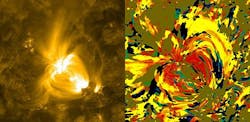Solar heating dynamics revealed by NASA colorful science
Greenbelt, MD--A new visualization technique created by Nicholeen Viall, a solar scientist at NASA's Goddard Space Flight Center, creates images of the sun reminiscent of Van Gogh with broad strokes of bright color splashed across a yellow background. Her technique is not purely art, but is also quantitative science: the color of each pixel contains a wealth of information about the 12-hour history of cooling and heating at that particular spot on the sun, a heat history that holds clues to the mechanisms that drive the temperature and movements of the sun's atmosphere, or corona.
"We don't understand why the corona is so hot," says Viall, who wrote about the technique in the July 1 print and June 12 online publication The Astrophysical Journal. "The corona is 1,000 times hotter than the sun's surface, when we would expect it to get cooler as the atmosphere gets further away from the hot sun, the same way the air gets cooler further away from a fire." Scientists generally agree that energy in the roiling magnetic fields of the sun must transfer energy and heat up into the atmosphere, but the exact details of that process are still debated. Viall created her technique to see if she could distinguish between theories that describe coronal heating as uniform over time, versus those that say it comes from numerous nanoflares on the sun's surface.
Using high-resolution images from NASA's Solar Dynamics Observatory (SDO) Atmospheric Imaging Assembly (AIA), images of the sun are provided in ten different wavelengths, each approximately corresponding to a single temperature of material. Therefore, when one looks at the wavelength of 171 Angstroms, for example, one sees all the material in the sun's atmosphere that is a million degrees Kelvin. By looking at an area of the sun in different wavelengths, one can get a sense of how different swaths of material change temperature. If an area seems bright in a wavelength that shows a hotter temperature an hour before it becomes bright in a wavelength that shows a cooler temperature, one can gather information about how that region has changed over time.
To study such temperature changes, many scientists focus on analyzing a specific subset of solar material, such as giant arcs of charged particles that leap up off the sun's surface called coronal loops. Scientists gather information about the loops by comparing nearly simultaneous images of the sun in different wavelengths. Analysis of the loops in each image requires time-consuming, manual analysis to subtract the background observations away from the loops themselves, a process which is also inherently subject to human judgment and bias. In addition, each individual image represents light from only a narrow range of wavelengths, representing material at a narrow range of temperatures.
Viall wanted to look at as much of the solar material in a given area of the corona as she could, incorporating information about a variety of temperatures simultaneously. She also wanted to avoid the subjective process of subtracting out the background. Instead, she decided to look at all light coming from a given spot on the sun at the same time. That meant coming up with a visualization technique to convey all that information at once, which was the impetus for her Van Gogh-like images.
For an interesting spot on the sun, Viall examines six channels over an entire 12-hour stretch. She compares each channel to the other channels in turn, assigning it a red, orange, or yellow color if the area has cooled, and assigning it a blue or green color if the area has heated up. She assigns the exact shade of the color based on how much time it took for the temperature change to occur.
"In essence, I'm measuring the time lag of how long it takes a given area to heat up or cool down," says Viall. "But it's totally automated, with no need for humans to make a decision about what to incorporate or ignore. And all of the solar material is represented statistically, not just one wavelength of light."
Viall's images show a wealth of reds, oranges, and yellow, meaning that over a 12-hour period the material appear to be cooling. Obviously there must have been heating in the process as well, since the corona isn't on a one-way temperature slide down to zero degrees. Any kind of steady heating throughout the corona would have shown up in Viall's images, so she concludes that the heating must be quick and impulsive--so fast that it doesn't show up in her images. This lends credence to those theories that say numerous nanobursts of energy help heat the corona.
SOURCE: NASA Goddard Space Flight Center; www.nasa.gov/mission_pages/sunearth/news/colorful-science.html
IMAGE:Nicholeen Viall, a solar scientist at NASA's Goddard Space Flight Center, creates images of the sun reminiscent of Van Gogh, but it is science, not art. The color of each pixel contains a wealth of information about the 12-hour history of cooling and heating at that spot on the sun, holding clues to what drives the temperature and movements of the sun's atmosphere, or corona. (Courtesy NASA/Goddard Science Visualization Studio)
